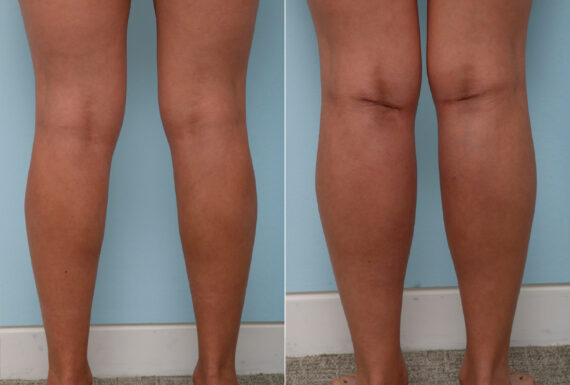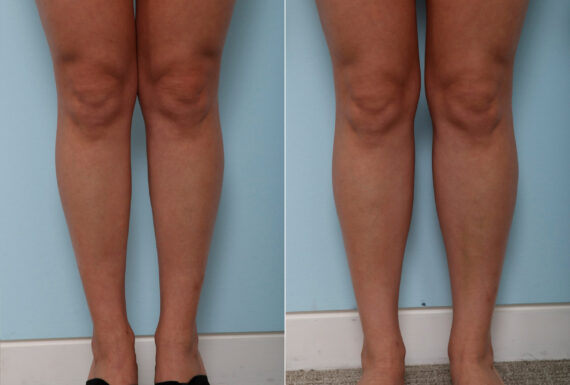Calf implants provide a way to improve the appearance or increase the size of the calves through surgery. The demand for this cosmetic procedure is increasing, as people seek it out for cosmetic enhancements and to rebuild the calf area due to muscle injury or disease. Dr. Paul Vitenas, with his extensive background in cosmetic surgery, shares his expertise about the safety and effectiveness of calf implants.
Balancing the potential benefits with the possible risks is crucial when considering calf implants. This information is aimed at helping readers understand what to expect from this surgery, understand the vital role of care after the operation, and evaluate other options for enhancing the calves so they can make an informed decision.

Understanding Calf Implant Safety
- Calf implants are generally considered safe but, like any surgery, carry potential risks such as infection and nerve damage.
- The rewards of calf implants include improved leg contour and enhanced self-esteem for those self-conscious about calf size.
- Proper consultation with a certified plastic surgeon is essential to minimize risks associated with calf implant surgery.
- Recovery from calf implant surgery involves rest and limited activity to ensure proper healing.
- Detailed pre-surgery discussions about your health and expectations can yield more satisfactory calf implant results.
Demystifying Calf Implants: Safety and Effectiveness
Calf augmentation is a procedure for people who want to improve the shape of their calves or address imbalances. It’s particularly helpful for those with underdeveloped calf muscles, helping to achieve a balanced and contoured lower leg appearance.
Exploring Calf Implant Types
Calf augmentation offers various options, including anatomical and symmetrical implants, to suit diverse aesthetic goals. Whether addressing asymmetrical calves or simply desiring larger calf muscles, individuals can find a suitable solution through this safe cosmetic procedure. Factors such as medical history, muscle sensitivity, and overall health conditions are thoroughly evaluated during the initial consultation to determine candidacy. The recovery phase, typically several days after surgery, involves managing postoperative discomfort and adhering to activity restrictions. Understanding the potential complications, such as capsular contracture or scar tissue formation, is crucial for informed decision-making. Patients can achieve their desired cosmetic outcomes by collaborating closely with a qualified surgeon and establishing a tailored surgical plan while ensuring a smooth recovery process.
Assessing the Risk: Safety Profiles of Calf Implants
Before considering calf implant surgery, patients undergo a health evaluation to lower calf implant surgery risks. An experienced plastic surgeon assesses the individual’s suitability for the procedure.
The process of calf implant insertion must be conducted with the utmost attention to safety. Detailed planning and execution are vital components of this surgical procedure. Here are critical steps for safety:
- Sterilization: All instruments and the operating area are kept sterile to avert infection.
- Precision: The shape and size of the implant are customized to the patient’s unique physique.
- Monitoring: Surgeons monitor patients during and after the surgery for immediate issues.
Risks are minimized with strict safety protocols, both in assessing patient health and during the calf implant insertion. This outpatient procedure demands a high level of care to maintain its reputation as a safe option in plastic surgery.
The Advantages: Benefits of Calf Implants
Improved Calf Contour and Symmetry
Calf implants deliver contoured calves with a balanced appearance. Individuals aiming to enhance their calves’ shape may find that implants provide a more attractive proportion. This is especially valuable for correcting asymmetries and achieving a consistent calf shape.
Psychological Boost from Enhanced Appearance
The psychological aspect is among the key benefits of calf implants. Many find that achieving shapelier calves through this procedure can improve self-esteem. This boost in confidence can positively influence well-being and provide a sense of fulfillment, especially for those who have long sought to improve the appearance of their calves with calf implants.
- Provides contoured calves with a balanced appearance.
- Corrects asymmetries for a consistent calf shape.
- Brings psychological benefits such as improved self-esteem.
- Offers a boost in confidence affecting overall well-being.
- Fulfills the desire for shapelier calves and dream calves.
Understanding the Risks Of Calf Implants
When considering calf implants, it’s crucial to recognize the potential complications that may arise post-surgery. While solid silicone implants generally pose fewer risks, issues like capsular contracture or scar tissue formation can still occur, necessitating additional procedures. Silicone gel implants, while offering a more natural feel, carry the risk of rupture or leakage over time. Additionally, factors such as muscle sensitivity and existing health conditions should be thoroughly evaluated during the initial consultation to ensure a safe procedure and satisfactory outcome. Understanding the terminology associated with calf implants and discussing aesthetic goals with a qualified surgeon is essential to selecting the most suitable implant type for individual needs.
Post-Operative Care for Calf Implants
Following calf implant surgery, attention to the recovery process significantly impacts the outcome. Patients must adhere to the instructions for incision care to prevent infection, ensure the incision area is cleaned, and monitor for any signs of redness or discharge. Painful recovery periods are manageable with proper pain management strategies and the recommended position for recovery, which also aids in reducing swelling and improving circulation.
In the weeks after calf implant surgery, watching for abnormalities is essential to stay on the right track to recovery. Patients should:
- Keep to their scheduled follow-up visits
- Monitor the incision sites as they heal
- Stay aware of any body changes, such as persistent pain or increasing swelling, which might indicate complications
Adopting a healthy lifestyle is part of long-term care to promote healing and protect the results of the surgery, keeping the body and human body in prime condition.
Measuring Success: Evaluating Calf Implant Outcomes
Assessing the Outcomes of Calf Implant Surgery
When considering cosmetic calf augmentation, achieving symmetrical and natural-looking results is paramount. The ideal candidate for this procedure undergoes a thorough initial consultation, where their medical history, aesthetic goals, and physical condition are carefully assessed. Silicone implants, commonly used in calf augmentation, must be placed strategically to minimize the risk of complications such as capsular contracture or scar tissue formation. The initial recovery period involves avoiding strenuous activities and adhering to the surgical plan outlined by the surgeon. Ultimately, a successful procedure enhances the appearance of the calf region while ensuring the patient’s safety and satisfaction with the outcome.
Importance of Follow-up and Revision Surgeries
During the initial recovery period following cosmetic calf augmentation, routine postoperative follow-up appointments are crucial to monitor the condition of the silicone implants and assess any signs of capsular contracture or complication. While calf implants are intended to be permanent, factors such as implant shifting or asymmetrical results may necessitate revision surgery. The surgeon will evaluate the patient’s aesthetic goals, medical history, and recovery progress to determine if further intervention is required. Patients must communicate any concerns or changes in their calf region during the postoperative period to ensure a safe and successful outcome.

Informed Consent: Understanding Calf Implant Surgery
Choosing a Board-Certified Surgeon
It’s imperative to consult with a board-certified surgeon when considering calf implant surgery. A plastic surgeon ready to communicate transparently can significantly influence your decision. During the calf implant augmentation consultation, you’ll gain insight into every stage of the procedure, including skin preparation and post-operative care.
Select a plastic surgeon with expertise in cosmetic and reconstructive surgeries. He or she should assess skin quality carefully and plan incisions to reduce visible scarring while improving the physical appearance.
Aligning Expectations with Reality
Ensuring that calf implants are safe and suitable for your body type is part of a thorough evaluation by a reputable surgeon. A well-known and well-respected plastic surgeon will set realistic goals regarding the enhancements you can expect, including a more masculine appearance if that is your aim.
Consider these factors:
- Implant size relative to your body
- Lifespan of the implants and need for adjustments
- The sensation of the implants beneath your skin
Calf implants should enhance, not dominate your physique. A qualified surgeon will ensure you make an informed, confident choice regarding calf implant surgery, emphasizing a balance between your expectations and the likely outcomes. They will guide you through understanding the entire calf implant surgery process, ensuring the results align with your body contouring procedure goals.
If you’re considering calf implants and want to understand the risks and benefits, getting advice from an experienced professional is important. Dr. Paul Vitenas is a well-respected, board-certified plastic surgeon with a long history of satisfied patients. With a focus on safety and beautiful results, Dr. Vitenas is known for his tailored approach to cosmetic surgery.
We encourage you to schedule a consultation with Dr. Vitenas to take the next step in your decision-making process. His expertise and commitment to patient care can help you make an informed choice. Contact our Houston office today to learn how calf implants might be right for you and to discuss your personal goals with our team.


